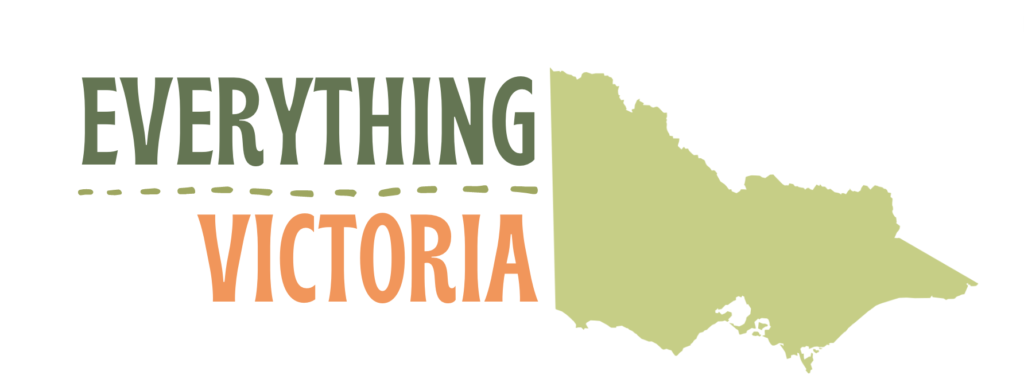If you were asked to name the most quintessential Aussie road trip, there’s no doubt in our minds that you’d settle on the country’s most iconic stretch of asphalt, located right here in the state of Victoria.
Yet, while most people set their sights on the Great Ocean Road, we’re here today to tell you all about an even better road trip destination: the Great Alpine Road.
In our opinion, it’s just as beautiful as its coastal counterpart.
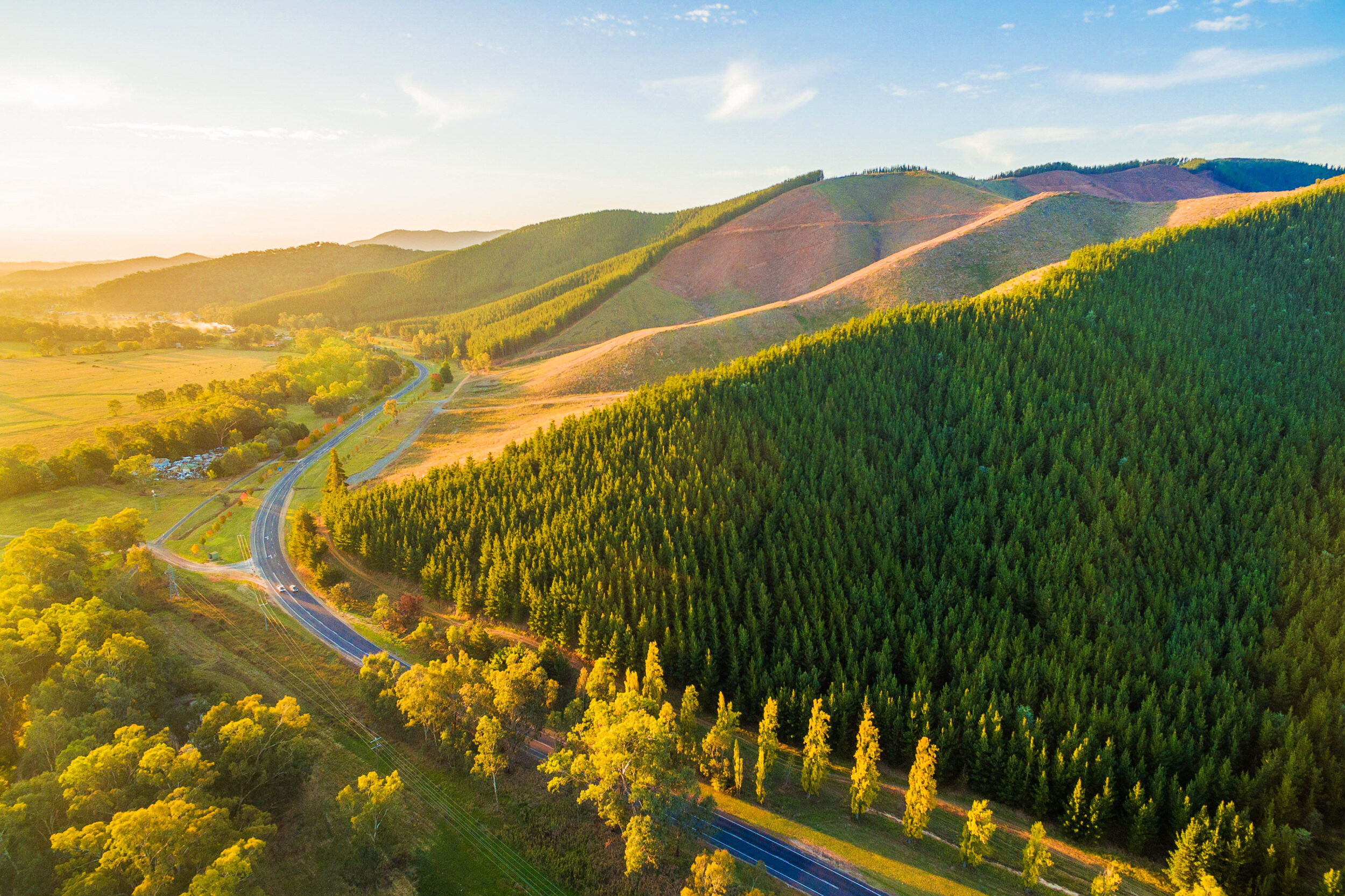
As the name implies, the Great Alpine Road leads you through the mountains of Victoria, on a 339 kilometre adventure that starts from Wangaratta in the north-east and ends in Bairnsdale in the south. Along the way, you’ll ascend from sea level to a breathtaking 1840 meters and back again, winding your way past snow-capped peaks, lush forests, and fertile valleys.
You’ll have the chance to hike to soaring mountain summits, dip your toes in crystal-clear streams, and explore charming towns drenched in gold rush history. And you can’t miss stopping off at one of the many wineries along the way, where you can sample some of the region’s finest offerings.
But what about the food? (And if you’ve read this site for any amount of time, you’ll already know that we’re all about the food). Well, the Great Alpine Road has you covered there, too. From hearty pub meals to gourmet farm-to-table concoctions, hipster vegan cafes to bustling craft breweries, there’s something to satisfy every taste and desire.
In the winter months, you’ll want to pack your salopettes and snow chains, as Victoria’s High Country transforms into a skier’s paradise; home to some of the best alpine resorts in the country. There’s plenty of other winter activities up for grabs, too, like snowboarding, snowshoeing, tobogganing, and snowmobiling. Or if you’re anything like us, you’ll be content to simply snap some photos of the wintry landscape, hot chocolate in hand.
When summer rolls around, the winter sports make way for hikers and cyclists, with rock climbers rounding out the trio. At this time of year, the mountains and valleys are covered in lush greenery, wildflowers bloom along the roadside, and driving the route means stopping off at scenic lookouts and picnic spots along the way.
You can wander the many hiking trails that lead to viewpoints and waterfalls, or try your hand at fishing in one of the sparkling rivers. The towns along the drive come alive with local festivals and markets, and there are so many wineries to help you sample some of the region’s finest produce.
In other words, the Great Alpine Road is truly a year-round destination that offers something for everyone. We love this part of Victoria and can’t stop singing its praises.
Dave and I have tackled the Great Alpine Road multiple times now, but it’s only after our most recent trip that we decided to sit down and finally put together the ultimate guide to the Great Alpine Road. We’ve noticed there’s a real lack of information around the logistics of this road trip, so this is the guide we wish we’d had when we were first driving south out of Wangaratta.
The History of the Great Alpine Road
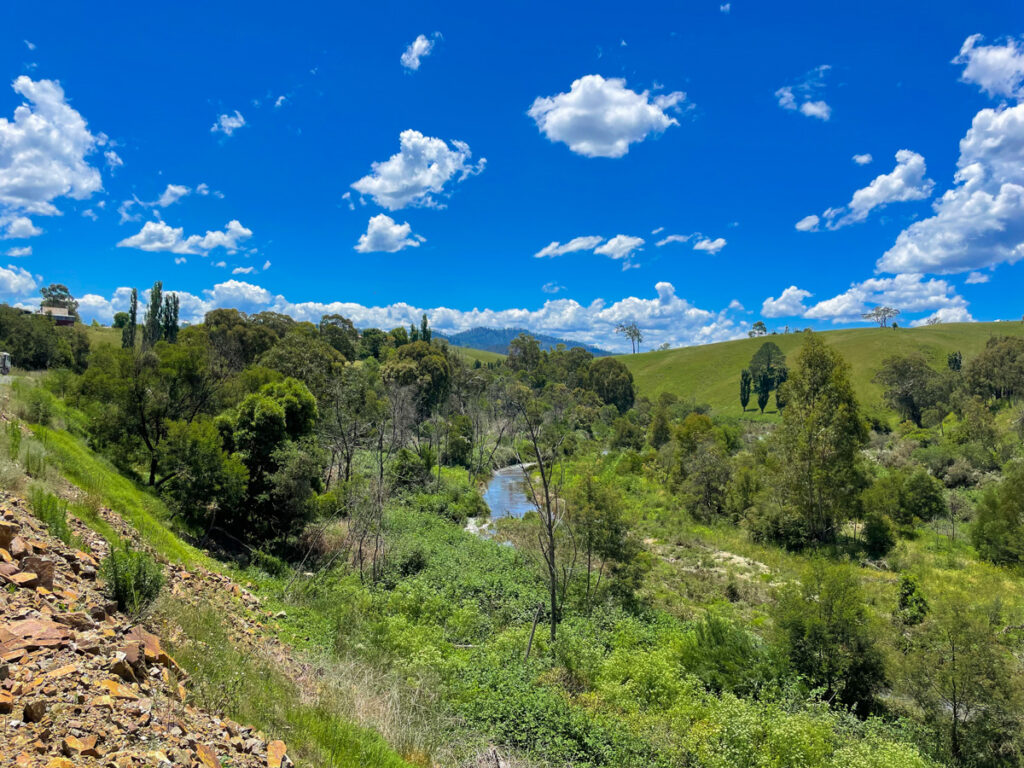
Did you know that the Great Alpine Road wasn’t always so picturesque?
The Great Alpine Road was initially built in the mid-1800s to provide access to the remote goldfields of the Victorian Alps. Back then, it was little more than a rough track, suitable only for horse and carts. But the gold rush had attracted a huge number of prospectors and miners to the region, so the route still played a crucial role in transporting people, equipment, and supplies to and from the goldfields.
The road was also used for other purposes, such as transporting timber from the forests of the region and providing access to the remote high country for grazing cattle and sheep. However, the road was often dangerous to drive, offering up steep inclines, hairpin bends, and unpredictable weather conditions.
In the late 1800s, the road was upgraded to accommodate motor vehicles, but it still remained a treacherous, winding route that was prone to landslides and washouts. It wasn’t until 1936, in fact, that the Great Alpine Road received its official name, after it was finally sealed, making it a much safer and more accessible route for motorists.
Despite the upgrades, it still remained a challenging drive well into the 20th century. In fact, at one stage, it was known as one of the most difficult roads to traverse in Australia. The route was often closed over winter due to heavy snowfall, and landslides were a common occurrence when it rained. Nevertheless, the road remained an important transport route for the region, connecting remote communities and enabling trade and commerce to blossom.
In the 1980s, major upgrades were finally made to the road, including the addition of safety barriers and the widening of the asphalt, making it the drive that we know today: beautiful, thrilling, and safe.
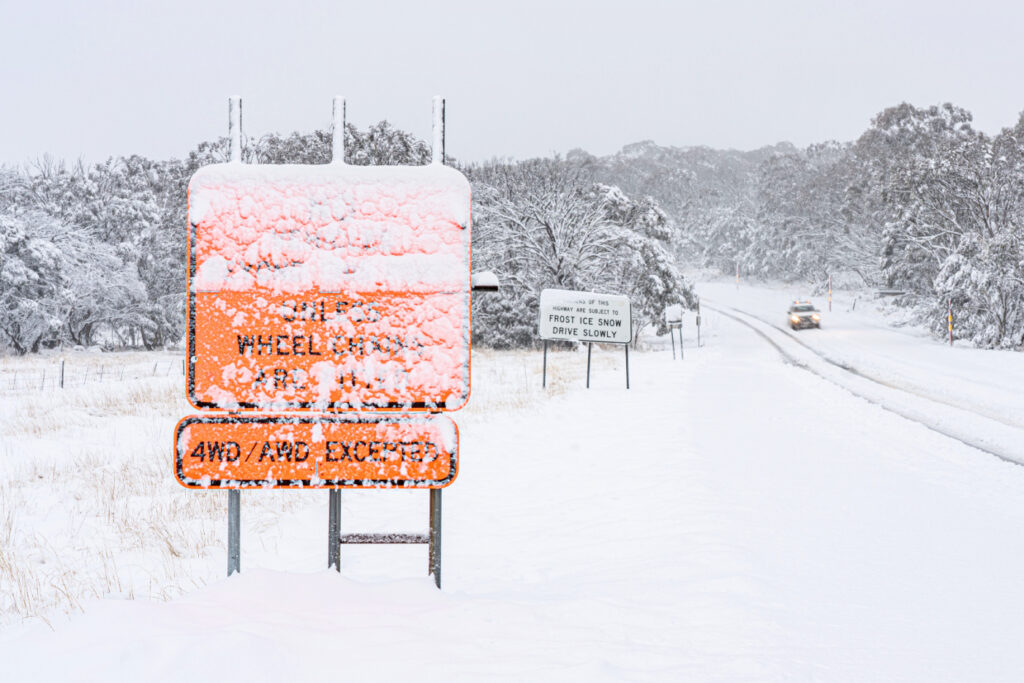
The Best Time of Year to Drive the Great Alpine Road
The best time of year depends entirely on what you’re looking to gain from your road trip — and that’s likely to be based around the weather. While the Great Alpine Road is open year-round, conditions can vary dramatically throughout the seasons.
Winter (June – August): Snow bunnies, listen up! If you’re on the hunt for the Australian skiing adventure of a lifetime, this is the time to go. You’ll be wanting to ensure you have chains packed in your car for any ice or snow you may encounter at elevation (it’s legally required to carry them between King’s Birthday on 12th June and the first weekend in October), but once you do, you’ll be good to go; this road will lead you straight into the heart of the Victorian Alps, where winter sports reign supreme.
The road is regularly cleared of snow during these months, so the driving shouldn’t be too daunting, but it can make for slow going when travelling up to the ski resorts. The vast majority of people tackle the drive for the skiing and snowboarding, but if you’re simply looking to cosy up inside with a hot chocolate in hand, gazing out at the dramatic scenery, you’ll be just as welcome.
Spring (September – November): Spring is a fantastic time to drive the Great Alpine Road. It’s not yet busy with holidaymakers, the weather is starting to warm up, and the Victorian Alps are blanketed in a sea of wildflowers, blooming alongside the road.
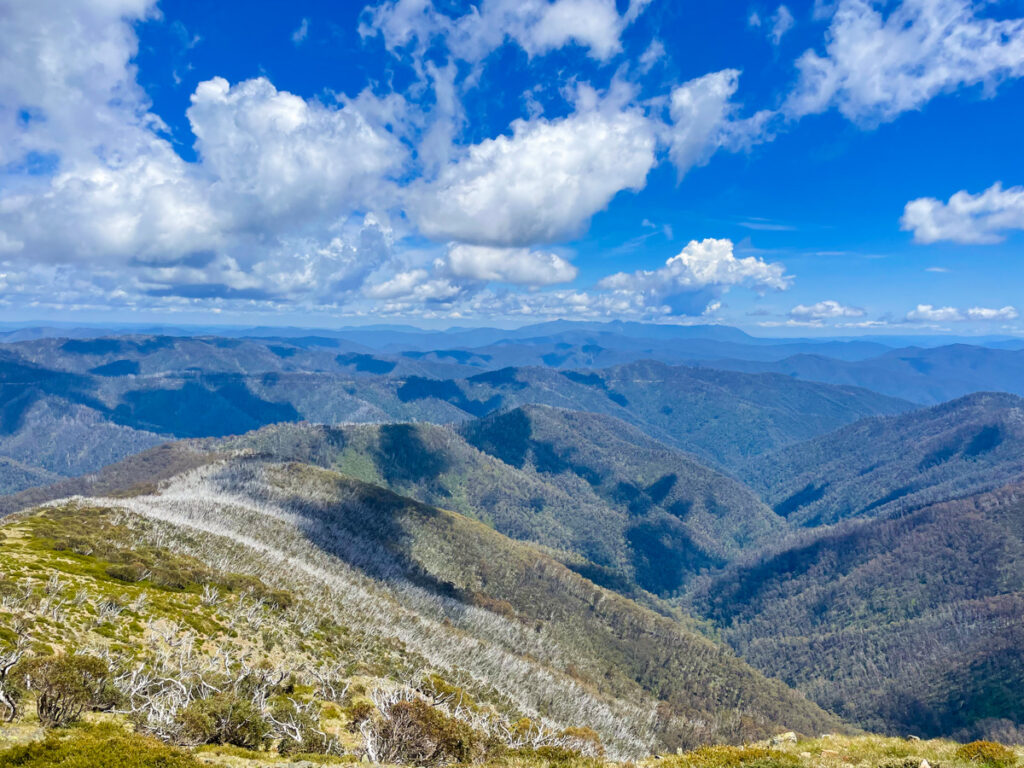
Summer (December-February): The summer months mark the most popular time to drive the Great Alpine Road, and for good reason. The weather is warm and sunny, making it perfect for outdoor activities like hiking and camping. However, be prepared for crowds, as this is the peak tourist season and the road can get busy. (It’s nothing like the traffic on the Great Ocean Road, though!)
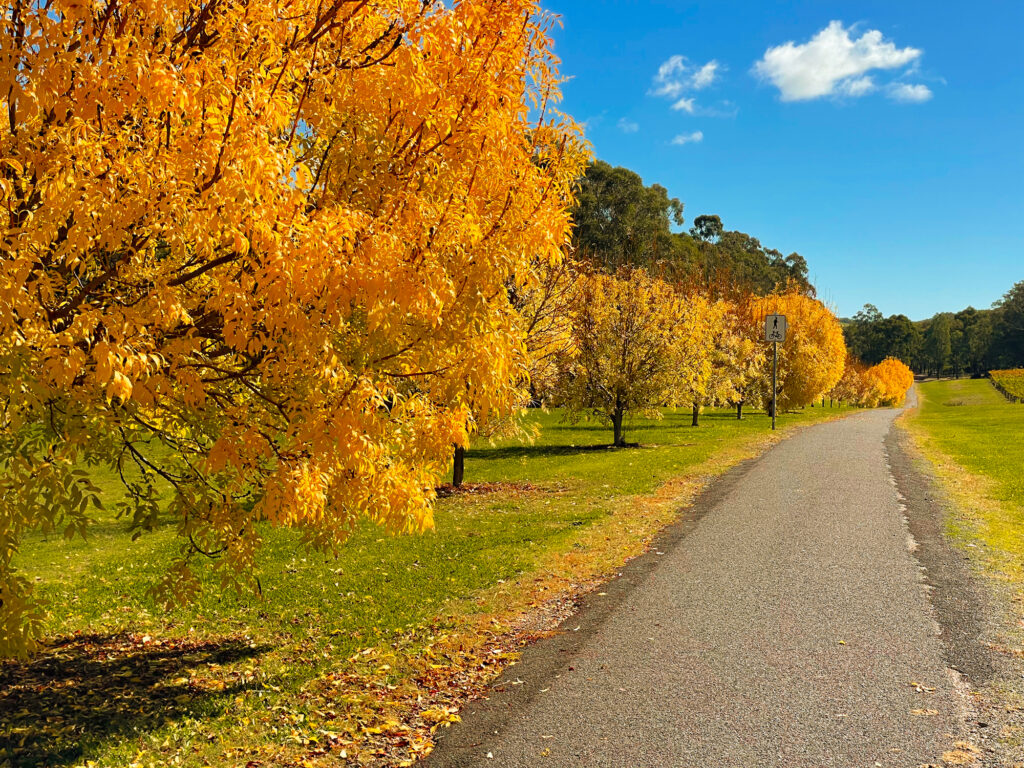
Autumn (March-May): If you want to experience the beauty of the changing seasons, then autumn is the perfect time to hit the road. The leaves on the trees turn to vibrant shades of gold, orange, and red, providing a stunning backdrop for your journey. The weather is still mild and the crowds have thinned out (with the exception of Easter and the Bright Autumn Festival) making it a quieter and more peaceful time to drive the road, too.
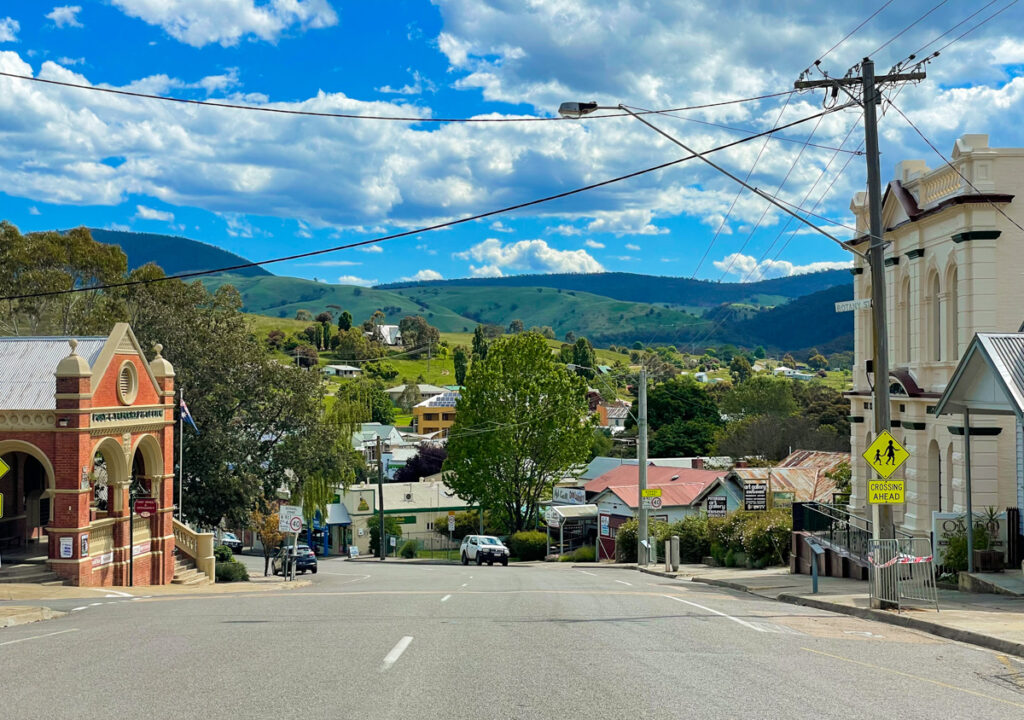
How Many Days is Right for You?
With so much to see and experience, you could easily spend an entire week hopping your way from village to town. You’d certainly never run out of things to do.
If you don’t have the luxury of all that time, however, we’ve always found three days to be the perfect amount of time. Here’s how we break it down:
- Day one: Wangaratta to Bright (83 km/52 miles)
- Day two: Bright to Omeo (110 km/68 miles)
- Day three: Omeo to Bairnsdale (121 km/75 miles)
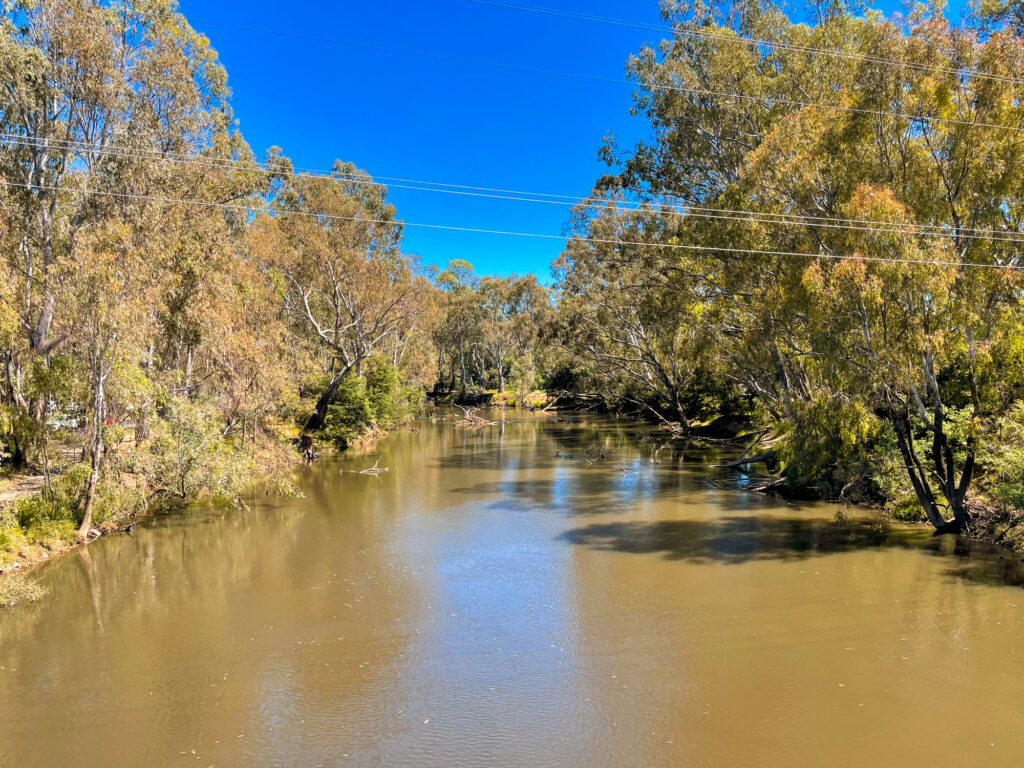
Day One: Wangaratta to Bright
The lovely town of Wangaratta — referred to simply as “Wang” by locals — marks the start of the Great Alpine Road. If you do have the time, it’s well worth spending a day here before setting off on your road trip, but if not, you can still gain a feel for it on the first morning of your trip. Take an hour to wander through the streets and stroll beside the river. Wangaratta’s laid back vibe is something to be savoured.
Our favourite breakfast spot is Cafe PreVue — a beautiful eatery that looks over the river, serving up delicious breakfasts: the perfect way to get your day started. I always order the tasty salmon nest while Dave recommends the full Vue breakfast.
When it’s time to hit the road, you’ll want to loosen your waistband even further in preparation: in case you haven’t yet gathered, driving the Great Alpine Road is quite the indulgent experience.
Before we continue, we first need to give a primer on day one. The journey from Wangaratta to Bright, where you’ll be staying overnight, covers a distance of 80 km and takes approximately one hour — it’s not a long drive! As a result, the primary focus of your first day will be on the detours. There are so many wonderful side trips you can take that will enable you to explore more of the region.
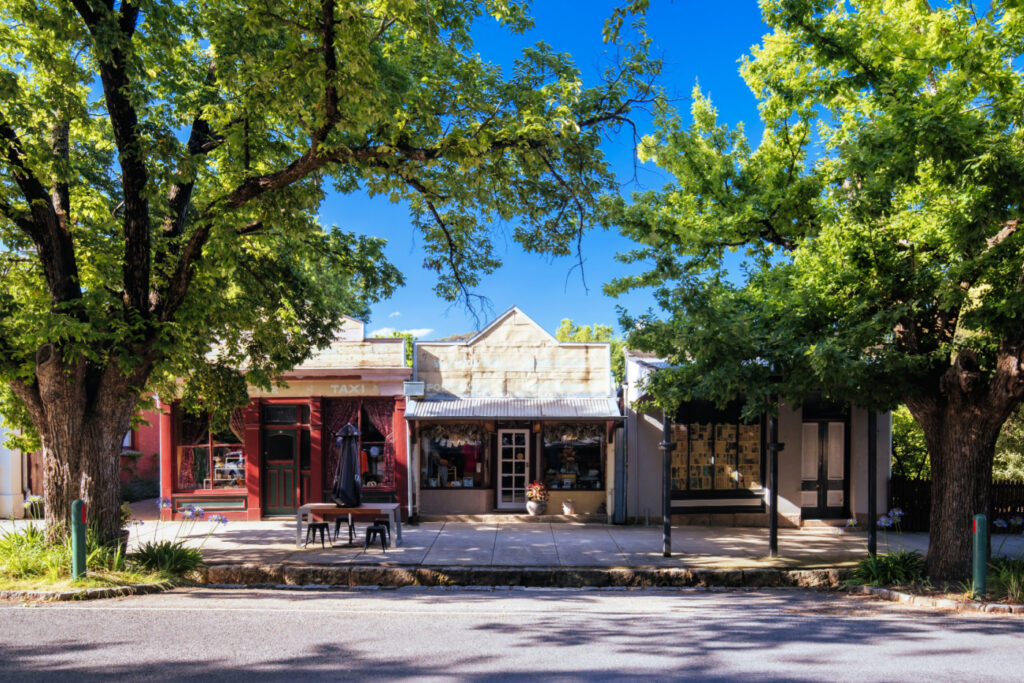
You’ve got three main options; you can easily tackle them all, or simply pick and choose the ones that most appeal.
- The Gourmet Food and Wine Drive: This scenic route leads you through one of the state’s best wine-producing areas and gourmet food destinations. Along the way, you’ll visit a variety of wineries, cellar doors, and artisan food producers — tastings available at almost all of them! — indulging in the region’s exceptional viticulture and culinary traditions. Opt for this side trip if you’re a true food and wine enthusiast.
- The Golden Heritage Drive: This detour is all about the region’s rich gold rush history. You’ll travel through historic towns, such as Beechworth, Yackandandah, Wooragee, and Tarrawingee, exploring preserved goldfield-era buildings, checking out the informative museums, and uncovering the gold rush’s impact on these communities. Choose this side trip if you’re eager to delve into Victoria’s golden legacy.
- The Mount Buffalo Drive: This detour starts from the town of Porepunkah, just 5 km before Bright, and takes you on a drive through the stunning Mount Buffalo National Park. You’ll be met with panoramic views of the Ovens Valley, Victorian Alps, and surrounding countryside. Once inside the national park, there are so many walking trails, beautiful waterfalls, and scenic lookouts to hit up. Go for this side trip if you’re passionate about outdoor adventures and hiking.
We’ve taken all three detours — some multiple times — and highly recommend doing the same. Indulging in delicious food and wine, immersing yourself in historic towns, and setting out on adventurous hikes: what more could you ask for?
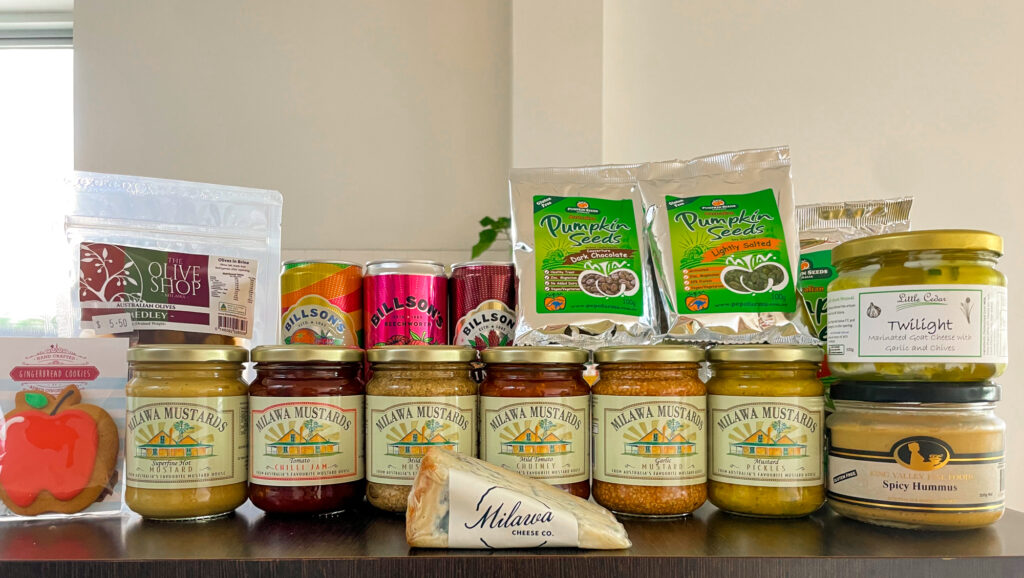
With all that being said, here’s how we recommend spending day one.
As you set off from Wangaratta, it’s time to take your first detour: on to the Gourmet Food and Wine Drive. This segment of your road trip leads you through the scenic Milawa Gourmet Region: a flourishing cool-climate wine territory, renowned for its abundance of wineries and farm shops. You can eat so well here, and we challenge you to not buy a product from every tasting you attend.
To get there, you’ll want to take the C521 road out of Wangaratta to Oxley, then make a left turn to Milawa. From this point forward, you’ll meander your way around picturesque vineyards and bustling farm shops, indulging in the region’s exquisite local produce.
As you can see from the photo above, we love supporting local businesses here at Everything Victoria, so picked up some goodies from practically every store we passed.
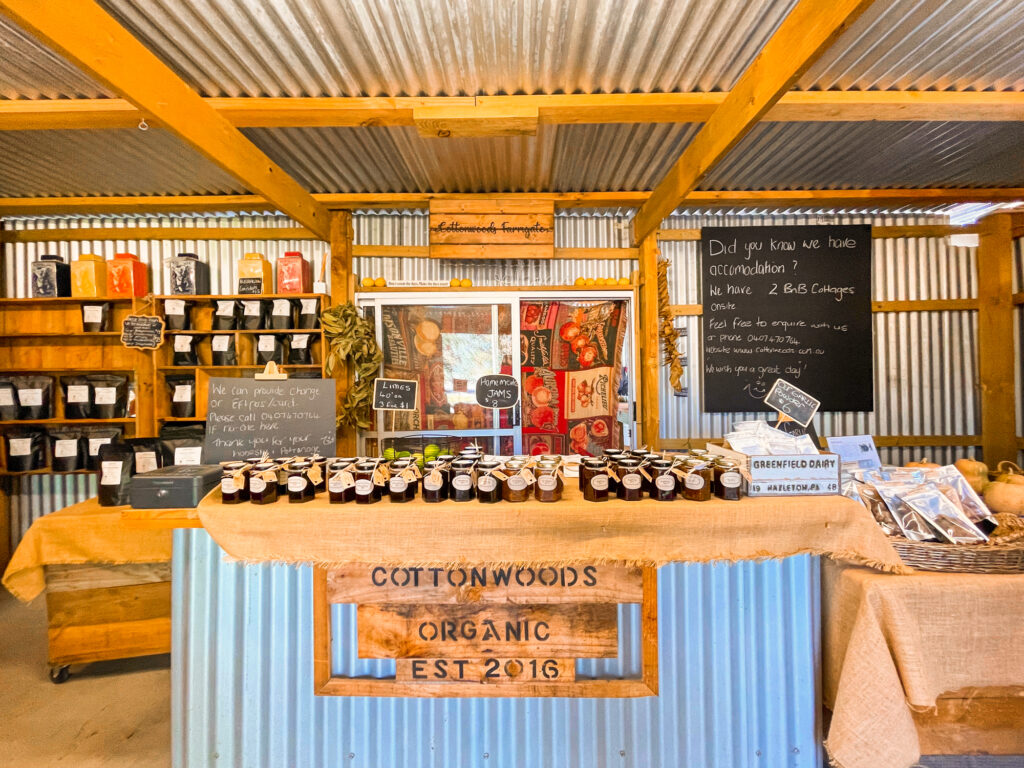
In terms of must-sees, there’s a whole bunch of produce stores located within a few kilometres of each other, so pick and choose the ones that appeal the most; it won’t take much more than an hour to visit them all.
The Milawa Cheese Company is one of the most popular places to stop at, offering sumptuous tastings at their cellar door; we tried nine of their most popular cheeses then bought the delicious blue goat cheese to bring home with us. You’ll find Milawa Bread next door: a lovely bakery offering sandwiches, pies, and fresh loaves of bread.
We’re also ridiculously huge fans of Milawa Mustards; at present they’re offering six jars for the price of five so of course we had to snap them up! They focus primarily on mustards (we love their garlic mustard and English mustard), but offer chutneys, relishes, and pickles, too.
The Milawa Olive Shop is the only produce store we visited that didn’t offer free samples, but the cost of the tasting is redeemable against the price of the product if you decide to make a purchase. Dave and I have eaten olives all over the globe, thanks to our decade-long career as travel writers, and can verify that their Italian-, Greek-, and Spanish-style olives are just as good as the ones you find in Europe! We picked up a mixed bag because we just couldn’t decide which variety we liked most.
If you skipped breakfast in Wangaratta, Milawa Bakery Cafe is located next-door to the Olive Shop and offers up some tasty sandwiches and pies, with gluten-free and vegan-friendly options available, too. We stopped in for brunch on our most recent visit and came away raving over their pies.
In terms of other places to visit, Walkabout Apiaries is an adorable little honey farm with plenty of unusual varieties to sample — as well as a range of delicious mead! If you’ve never had mead before, this is the place to try it. We also recommend the Organic Farm Shop for a fabulous selection of locally-produced sauces, chutneys, honey, and preserves — we adore their chilli plum sauce.
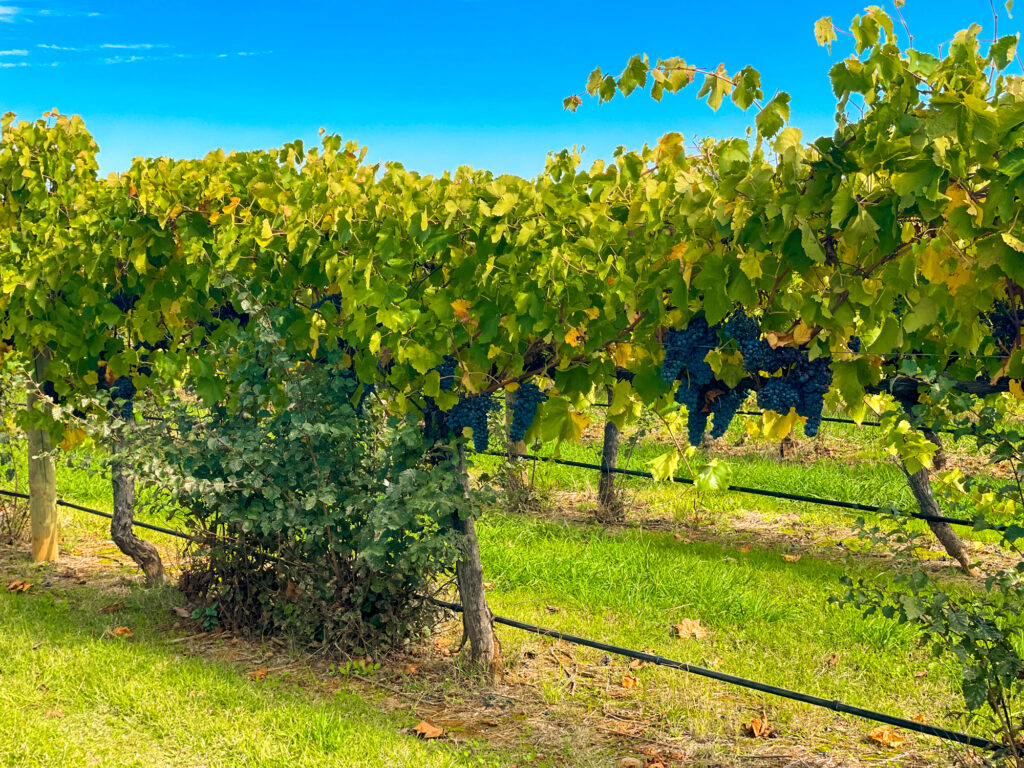
Now that your stomach is full of food and your car is full of purchases, it’s time to wash all those tastings down with some of the state’s best beverages.
We highly recommend starting at Brown Brothers’ cellar door, with nearby Wood Park Wines offering an equally as wonderful tasting option . However, if you’re looking to break away from the traditional winery scene, we suggest heading over to Hurdle Creek Still — a rustic gin distillery producing an array of unique drinks. A tasting fee of $10 is applicable, but it’s redeemable against any purchase made. While the aniseed gin is a fan favourite, we personally find the yuzu flavour to be the most interesting.
And with that, your Milawa wine and food odyssey is complete. Now, we recommend driving on to beautiful Tarrawingee, to begin your journey on the Golden Heritage Drive.

Tarrawingee is the first of the gold rush towns you’ll visit today; unsurprisingly, it’s home to a rich history.
The town’s heritage can be seen in its well-preserved architecture, specifically the iconic Plough Inn Hotel, built in 1864, which once served as a popular meeting point for gold miners. Today, the hotel continues to operate and offers a warm and welcoming atmosphere for locals and visitors alike; it’s a great option for lunch if you decided to skip eating in Milawa.
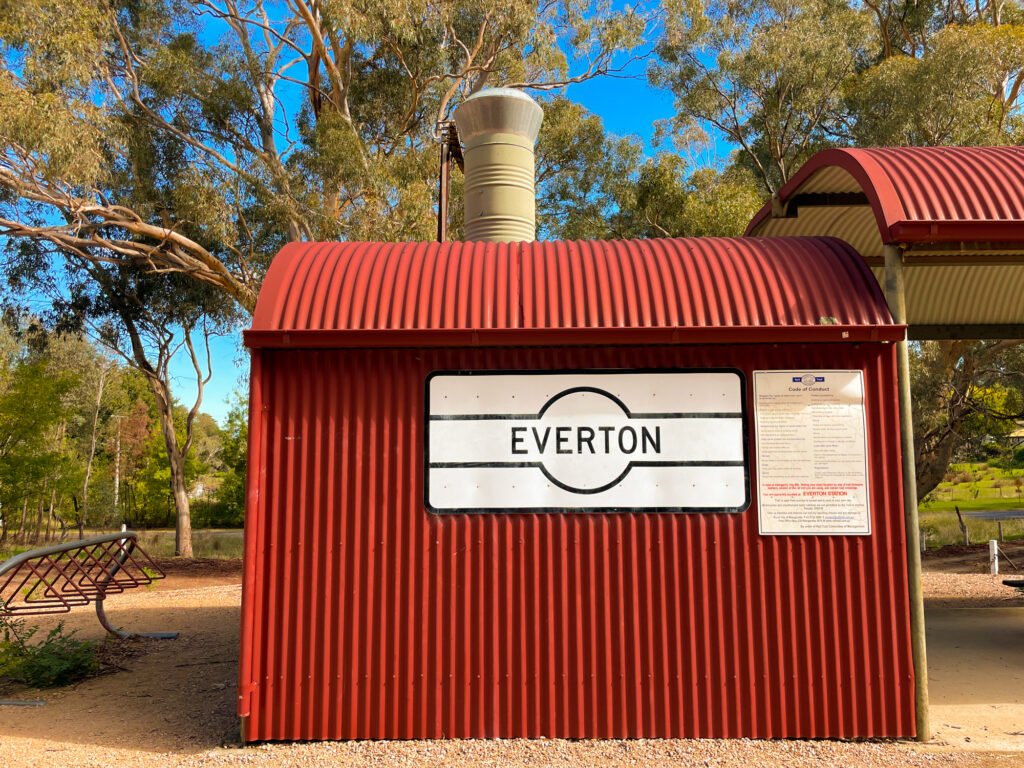
You’ll be heading to Beechworth next, the most famous of the gold mining-era towns, but on the way, you’ll drive past Everton. We recommend taking a quick detour to visit its disused railway station, which is part of the Mountains to Murray rail trail. There’s nothing much there — the bike path and some toilets — but the station does look particularly retro, so it’s worth taking a look and snapping a few photos.

Drive on to beautiful Beechworth next. It’s a wonderful town to spend an hour or two, renowned for its colourful buildings and beautiful scenery. Like Tarrawingee, the town was founded in the mid-1800s during the gold rush era, and many of its buildings date back to that time period.
If you do just one thing in Beechworth, make it visiting the Beechworth Gaol, which was built in 1864 and operated as a prison until 2004.
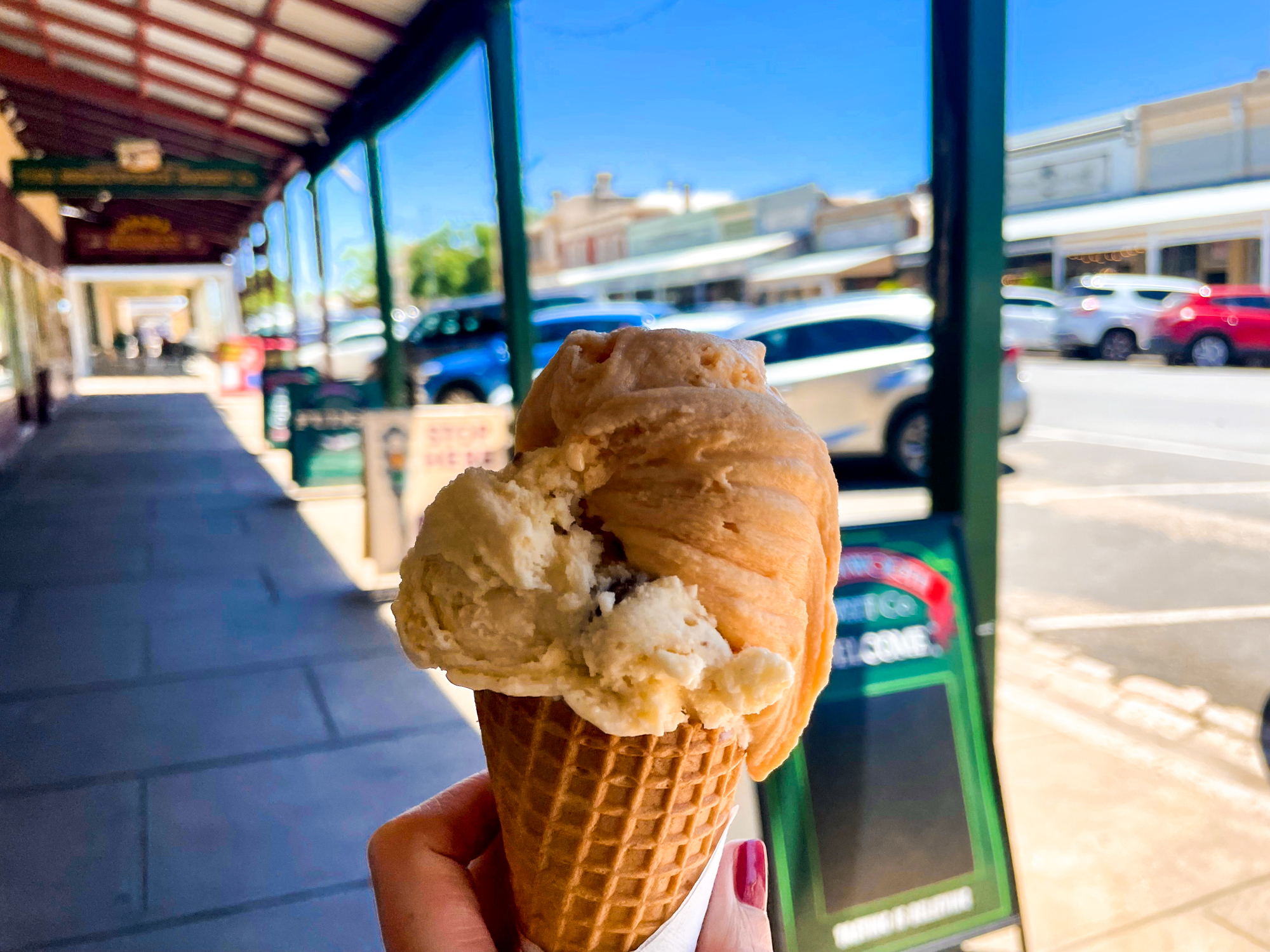
Beechworth is also known for its natural beauty, with several parks and reserves located in and around the town. The 7 km Beechworth Gorge Walk is a popular hiking trail that offers stunning views of the surrounding countryside, while the Woolshed Falls walk — which takes around 20 minutes to complete — provides a peaceful spot for a swim or a picnic. (If you’ve picked up some goodies from the farm shops along the way, you may want to do just that!)
In addition to its historical and natural attractions, Beechworth is known for its food and beverage scene. The local craft brewery — Bridge Road Brewers — is absolutely fantastic and our recommended lunch spot, and we’re also huge fans of La Blanche Ice Creamery if it’s a hot and sunny day.

Now, technically the next part of the road trip takes you to Wooragee and then Yackandandah. If we’re being quite honest, though, you can absolutely skip over Wooragee. It’s small and quiet and doesn’t have much going on — and the architecture isn’t as impressive as it is elsewhere. No, instead, we recommend driving straight to Yack.
Walking along the quaint streets of Yackandandah, you can’t help but feel transported back in time. Many of the well-preserved buildings here date back to — you guessed it! — the gold rush era, giving the town a lovely historical vibe. We took a leisurely stroll down the main street and found adorable shops, cosy cafes, and friendly locals who were eager to share their stories and love for their town.
One thing that truly stood out during our visit was the strong sense of community in Yackandandah. From local markets and art galleries to annual festivals and events, this town is buzzing with creativity and camaraderie. We have a friend who decided to move here from Melbourne several years ago — at first, we were surprised by her choice, but once we made it out to see her, we could easily see the appeal.
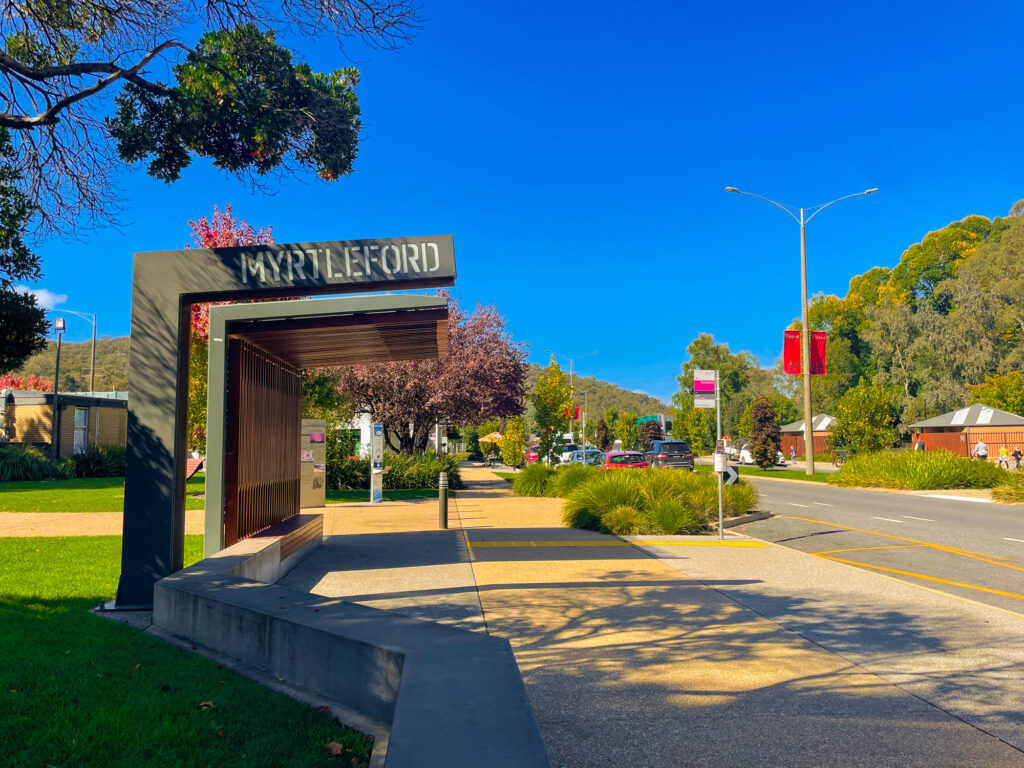
Back on the road again, set your GPS for the delightful town of Myrtleford, located in the Ovens Valley.
One interesting aspect of this town is its rich history in tobacco farming, which significantly influenced the town’s growth and development during the 20th century. Myrtleford was once considered the tobacco capital of Australia, with its fertile land and favorable climate providing ideal conditions for growing the crop.
Although tobacco farming has since ceased in the area, its distinctive, A-frame buildings are still visible today through the iconic kilns that are scattered throughout the region. Be sure to check out the well-preserved historic log tobacco kiln in Myrtleford’s centre to learn more about the town’s agricultural past.
Today, Myrtleford is known for its thriving wine and food scene. We recommend stopping in at Pepo Farms — a pumpkin seed farm — on the outskirts of town to sample its produce. This was one of our favourite discoveries from our most recent road trip: we ended up buying some pumpkin seed oil and three bags of different flavoured pumpkin seeds after joining the free tasting. Our favourite was the hot cajun variety, with the dark chocolate coming in at a close second.
You can’t say we didn’t warn you this road trip was going to be about indulgence!
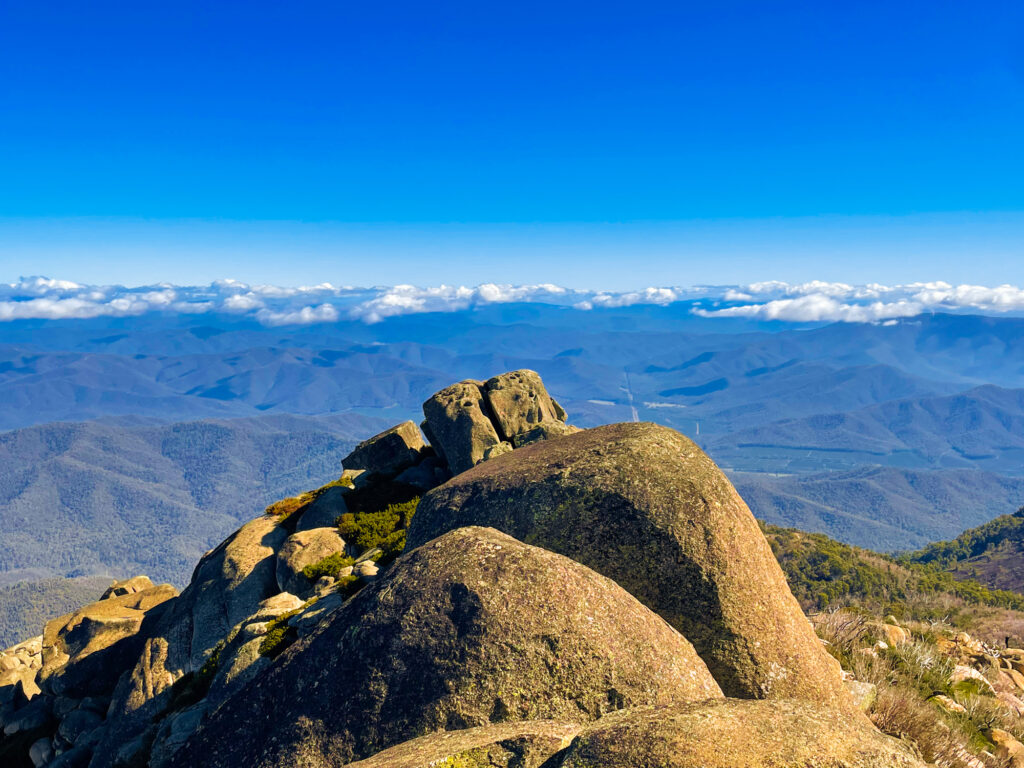
If there’s still time left in the day, it’s time to jump on your final side trip; this one to Mount Buffalo National Park. A couple of hours here will allow you to explore a considerable part of the park, so don’t hesitate to take the detour if time permits.
Kick things off by turning right when you get to Porepunkah, located just 6 km before Bright. The turnoff will take you straight on to Mount Buffalo Road, which then leads you through the national park. You’ll be able to gain a pretty good taste of the area’s unique landscapes along this road, and if you’re lucky, spot kangaroos and wombats from the asphalt.
There are over a dozen short hikes in Mount Buffalo National Park, many of which are just as scenic as the longer treks. With a limited amount of time, we recommend the Eurobin Falls Track (1.4 km return), which takes you to two remarkably impressive waterfalls, and the Gorge Heritage Walk (2.5 km loop), which offers up tons of great viewpoints of waterfalls and mountains. These trails are suitable for most fitness levels and Dave and I completed each of them in under an hour.
If you still have time after the walks, drive up to The Horn, the highest point in the park at 1,700 meters. A short 15-minute walk will take you to the summit, where you’ll be rewarded with epic panoramic views of the surrounding mountains. We were seriously impressed by this lookout, although warn you to expect to share it with a dozen other people at once.

You’ll finish your day of adventure in Bright.
Now, Dave and I adore Bright. So much so that we often spend two or three nights here, hiking in the surrounding hills, walking alongside the river, and soaking up the outdoorsy vibe. Bright used to be home to the Adventure Travel Film Festival, when each and every February, Dave and I would pack our backpacks and set off for a weekend of movies and inspiration. We subsequently know this town like the back of our hands and believe you could spend weeks here without getting bored.
For such a small place, it offers up an impressive array of fantastic eateries.
When it comes to the evening’s meal, however, we recommend heading to the Bright Brewery: the iconic beating heart of the town. With a vast array of freshly-brewed beers and tasty pizzas, you’re in for a relaxed, casual meal, spent sunning yourself in their beer garden or cosying up inside, depending on the weather.
Where to Stay in Bright
Dave and I usually opt to stay in Bright Motor Inn while we’re in town. In a place that’s inordinately expensive when it comes to accommodation, Bright Motor Inn is the best-value spot we’ve found, coming in at $160 a night for a double room. The room is clean and modern, the internet works well, and there’s even a fridge to keep your Milawa haul cool.
The property has a BBQ and swimming pool on site, which is fabulous during those hot summer months, and the staff are wonderful and welcoming. We highly recommend it.
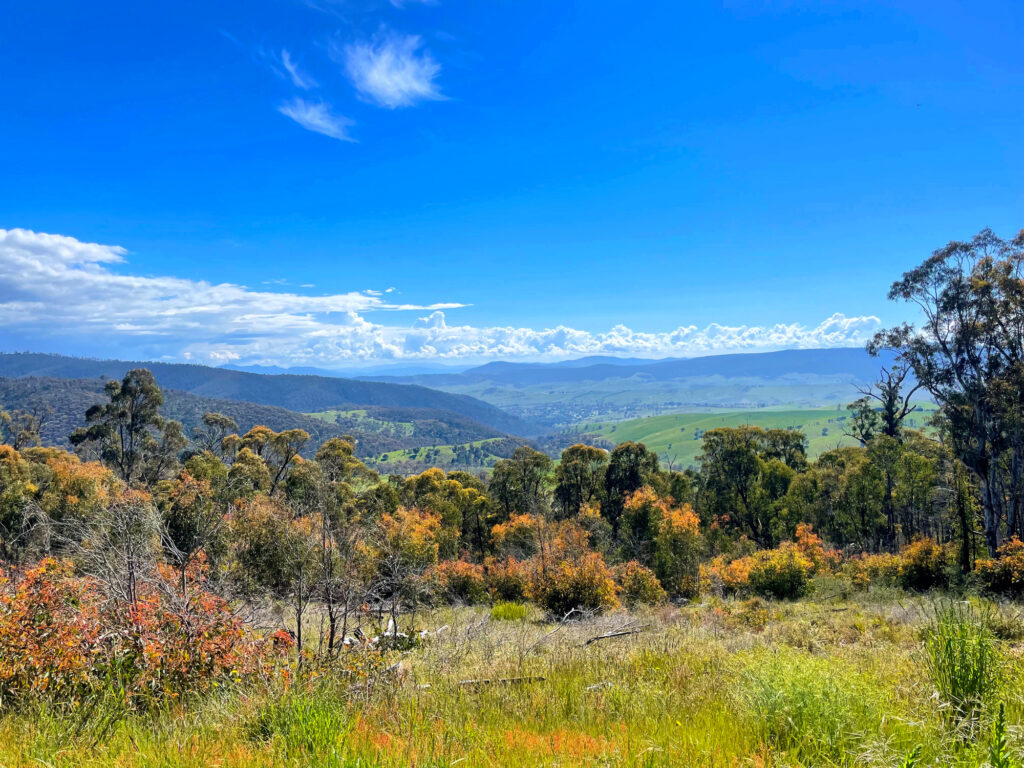
Day Two: Bright to Omeo
There are a wide array of healthy cafes in Bright, so it can be hard narrowing your choice down to just one. We recommend Wild Thyme — their smoothie bowl and big breakfast is delicious, and there are plenty of vegan options on the menu, too.
Your second day on the Great Alpine Road will take you from Bright to Omeo, and this section of the trip? This is when you’re going to see how the Great Alpine Road got it’s name.
Yep, it’s time to get high.
After you bid farewell to Bright, you’ll soon come across Harrietville, a small mountain village that marks the beginning of your ascent to Mount Hotham.
Harrietville isn’t super-exciting but it is home to a couple of interesting spots: in particular, the restored Star Hotel and the Harrietville Museum; the latter of which is only open at the weekend. The village has a relaxed and welcoming atmosphere, so if you’re keen to get out and stretch your legs, this is a lovely place to have a brief wander.
After leaving Harrietville, you’ll begin to ascend the mountain, and I want to stress that it’s important to pay close attention to the road from this point forwards. Be prepared to encounter steep drops on the left-hand side: they can be a little nerve-wracking at times, especially when vehicles are passing by on the right. Crash barriers have been placed in front of the most precipitous of drops, but they’re still not everywhere.

Make your way further over the Alps, until the mountains look as though they stretch on forever. Up here in the high country, there’s ski resorts galore, small villages, and a wealth of alpine hiking trails, all at an elevation of 1,800 metres, or 6,000 feet.
Those silvery patches of forest you see in my photos are the local Alpine Ash trees. A lot of them didn’t make it through bushfires — yes, there are even bushfires up at this elevation — but their bright-white remains add a unique sparkle to those panoramic views.
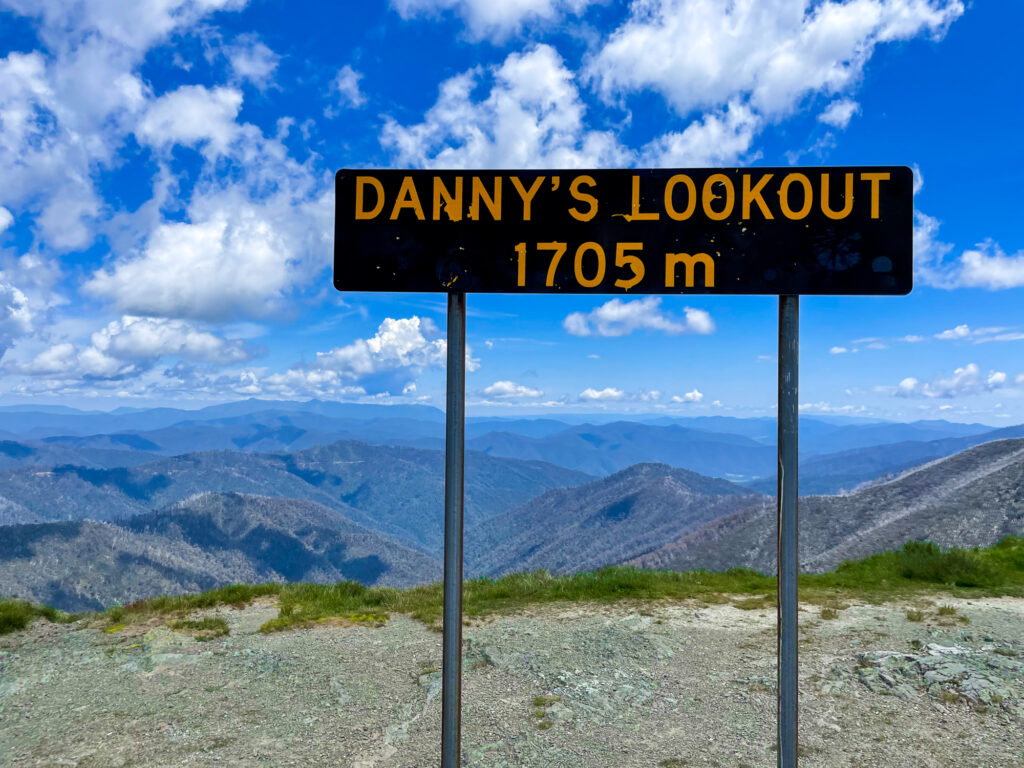
There are plenty of viewpoints along this part of the road, and you could pull over every couple of minutes to snap photos from a dozens of slightly different angles. If you choose just one, though, make it Danny’s Lookout, at 1700 metres high. From there, you can look back towards Mount Buffalo, where you were hopefully hiking less than 24 hours ago.
As soon as you cross over the highest point on the road, you’ll leave the views of Mount Buffalo National Park behind, and instead be gazing out into Alpine National Park. The scenery is truly unbeatable out here, regardless of whether you’re cruising along in summer or navigating cautiously in winter.

Next, you’ll pass the alpine resort of Mount Hotham, where you’ve got the option of an epic day hike if you’re down for the challenge.
Located within Alpine National Park, the Razorback Track is one of the best in the region, taking you along a striking ridgeline with panoramic views of the surrounding mountains and valleys. The end point is the summit of Mount Feathertop, the second highest peak in Victoria. It’s one of the most impressive, and aesthetically pleasing, mountains in the region.
The trail starts from the Diamantina Hut, close to Mount Hotham, and altogether spans about 11 kilometers (22 kilometers return) and takes between 5 to 7 hours to complete the round trip, depending on your fitness level and time spent at the summit. The Razorback Track is moderate in difficulty, with some steep sections and uneven terrain, but it’s manageable for most hikers with a decent level of fitness.
As you make your way along the trail, you’ll be surrounded by even more alpine scenery, including vibrant wildflowers during the warmer months. Upon reaching the summit of Mount Feathertop, which stands at 1,922 meters (6,306 feet), you’ll be rewarded with exceptional views of the Victorian Alps — we think they’re better than the ones from the road — and the chance to enjoy a well-deserved rest.
It’s essential to be well-prepared for this hike, as the weather can be unpredictable and change rapidly in alpine regions. Make sure to wear appropriate clothing, carry sufficient water, food, and sun protection, and always inform someone of your plans before setting off on your adventure.
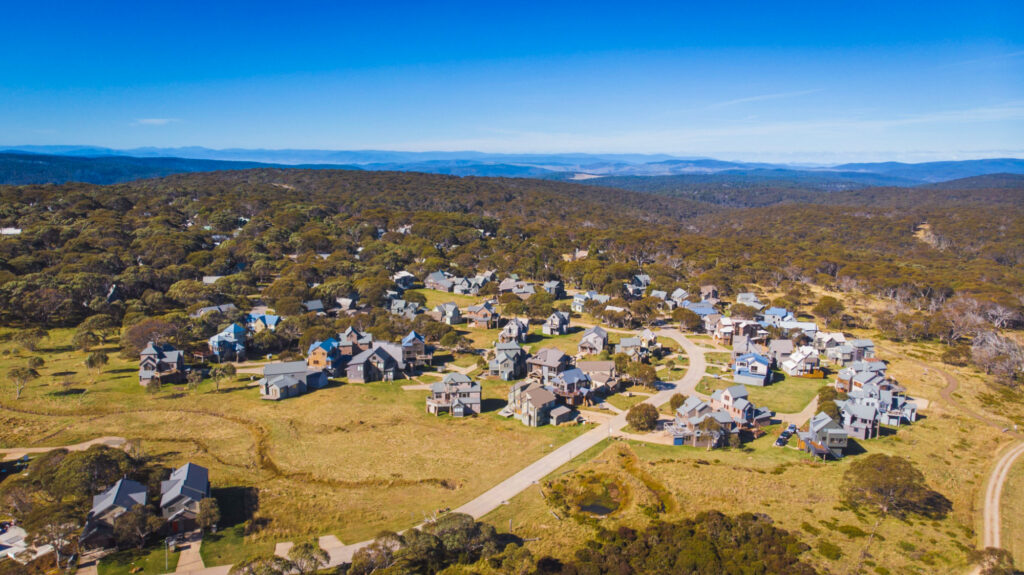
Whether or not you chose to hike Mount Feathertop, once you pass Mount Hotham, it’s time to head back down. Just like on the drive up, there are tons of great viewpoints and landscapes to take in.
Soon, you’ll come across the wonderful village of Dinner Plain, which marks a perfect spot to grab some lunch. We’re totally obsessed with the Mountain Kitchen cafe here and always make sure to stop by for a bite whenever we’re cruising along the Great Alpine Road — their sandwiches are a generous size and full of flavour.
Dinner Plain’s got events and activities happening all year round, so there’s often something fun to check out. Whether you’re into dog sled races, polo matches, bike races, or even the yearly “pub to pub” cross-country ski race, you’re sure to find something that’s right up your alley.
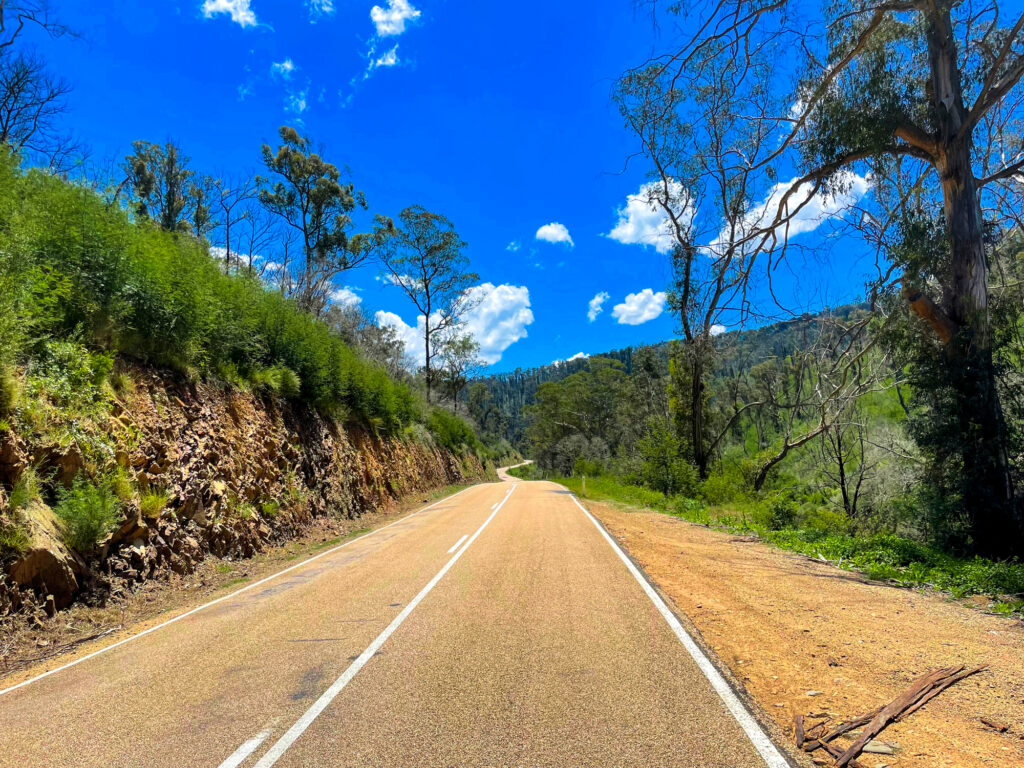
As you continue your descent towards Omeo, you’ll notice the scenery transform as you begin to pass forests, rolling hills, and expansive vistas. This section of the route continues to provide opportunities for photo stops, with several lookout points and rest areas set up wherever the scenery is most impressive.
Before long, you’ll be pulling up in Omeo, yet another historic gold mining town with the cutest old architecture. After dropping your bags in our room, spend some time wandering in the hills outside the town, taking photos of the buildings, and then resolve to never leave the local pub.
The Golden Age Hotel offers up the beer garden of your dreams: overlooking the town, with crisp, local white wines and some of the best fish and chips I’ve ever had (unexpected, considering its inland location). I think Dave and I sat in the sunshine for a solid six hours here on one of our previous drives before full-on declaring Omeo to be the greatest place in Victoria.
(Although that may have been the wines talking)

Where to Stay in Omeo
On our most recent visit, Dave and I stayed in the Romantic Rock Cottage and absolutely adored it! The Rock Cottage is located in the centre of Omeo and features an incredible stone wall that was part of the original road that was built in the late 1800’s during the time of the gold rush. It’s super well-equipped, peaceful, and has a sunny garden to relax in. I particularly enjoyed reading the books about Australian history that were kept in the living room.
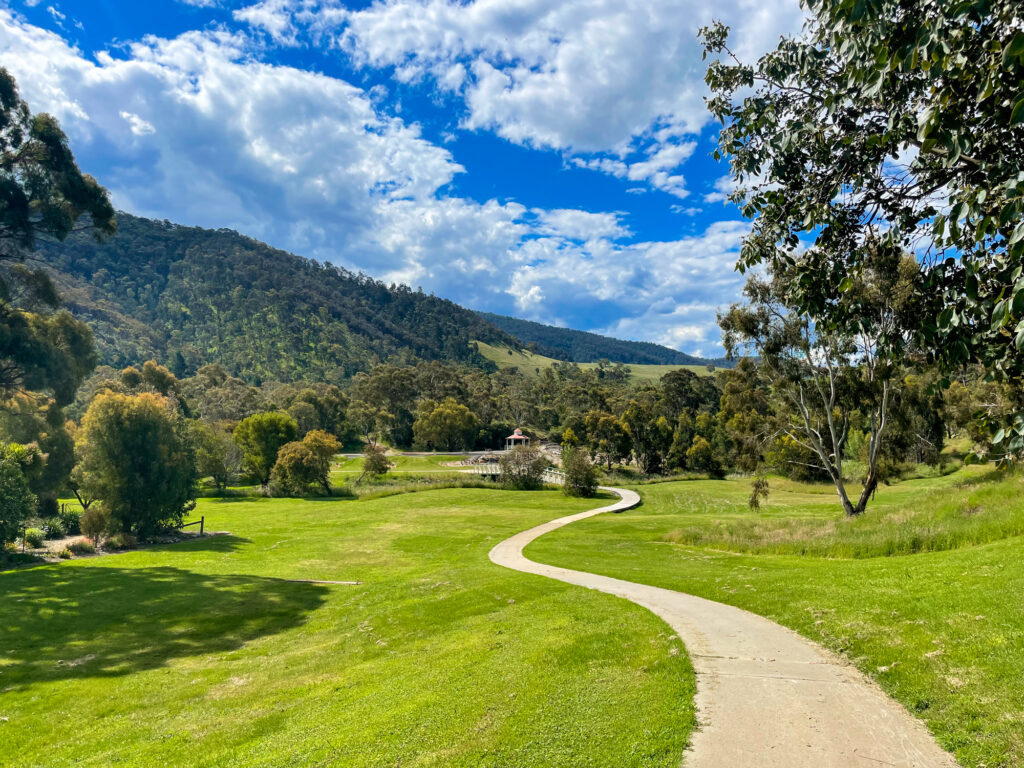
Day Three: Omeo to Bairnsdale
It’s the final day of your road trip and this leg promises to be just as enjoyable as the previous two.
After a restful night’s sleep, take a walk over to the Crazy Cow Cafe, where you’ll find an array of pies, cakes, sausage rolls, and tarts to help you fuel up for the day’s adventures. Before you say goodbye to Omeo, however, there’s one final activity we recommend jumping on.
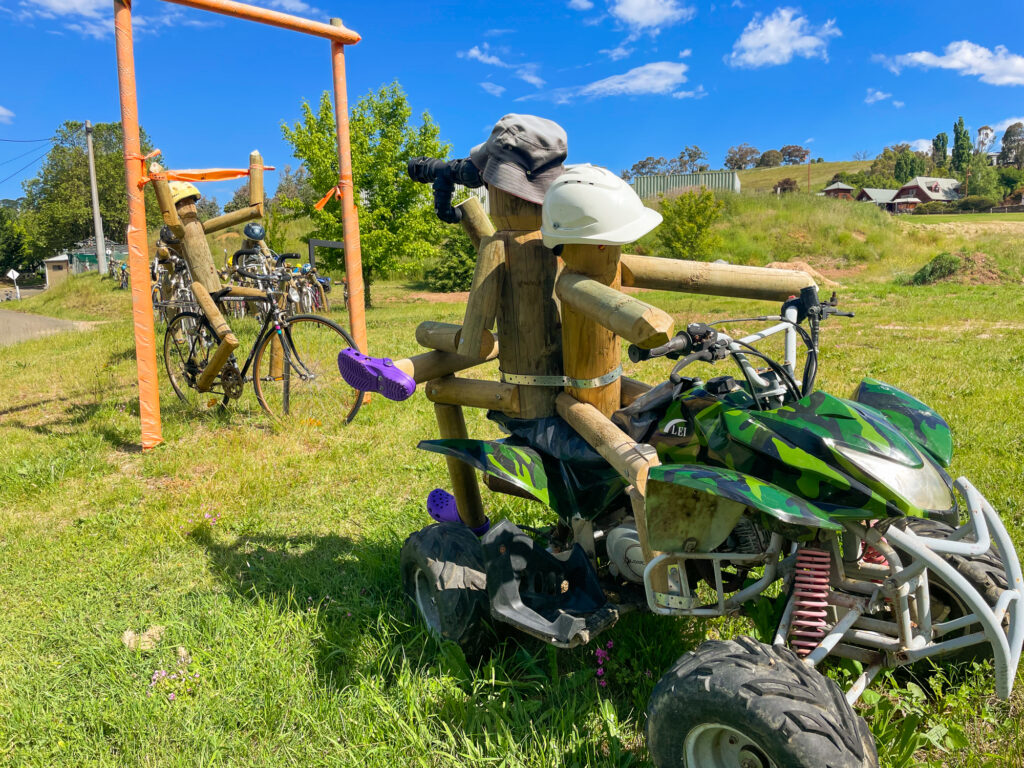
It’s time to go sculpture-spotting! These sculptures in Omeo have been created using an assortment of bicycles, bike parts, and wood, and are a true reflection of both the town’s creativity and its appreciation for cycling as a sport and recreational activity.
The sculptures are scattered all around town, so you won’t find it hard to spot them. Whether you’re a cycling enthusiast or simply an admirer of art and design, it’s well worth spending half an hour tracking some of them down.
And with that under your belt, it’s time to get your car back on the road!
Today, you’ll be making your way to the bustling city of Bairnsdale in Victoria’s Gippsland region, and this final leg of the road trip will take you through vast stretches of grazing country. It’s not as exciting as the dramatic scenery of the day before, but the landscapes are still impressive, and the Gippsland Lakes make for a majestic end point.
As you depart from Omeo, the road meanders alongside the Tambo River, providing views of the glistening water and surrounding hills. The area is abundant with native wildlife, and you may catch a glimpse of kangaroos, wallabies, and various bird species during your drive.
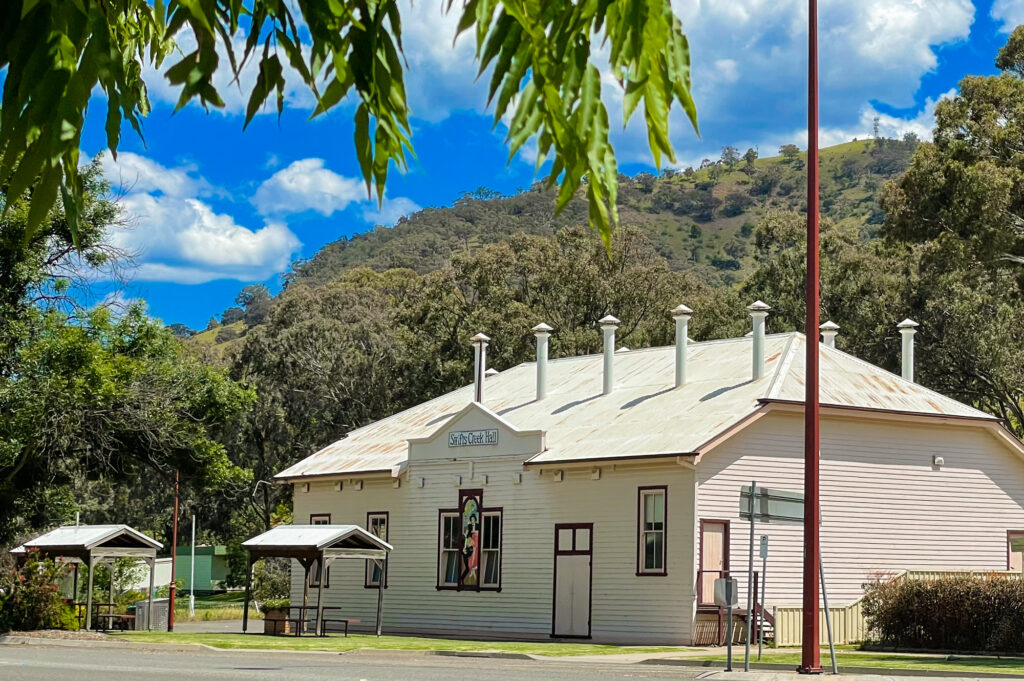
Swifts Creek is the first notable village you’ll pass through today, home to a handful of cafes and shops, and it makes an excellent spot to take a break from driving and stretch your legs.
Once a timber town that was home to sawmills and little else, this pretty town has reinvented itself as a hangout for local artists. Inspired by the countryside that surrounds them, these creatives often showcase their masterpieces in the local Great Alpine Gallery — well worth a look if you’re into your art.
Feeling the call of nature or looking for a chill spot to unwind? Right next to Swifts Creek Town Hall you’ll find public restrooms and a picnic table where you can kick back and have a snack.
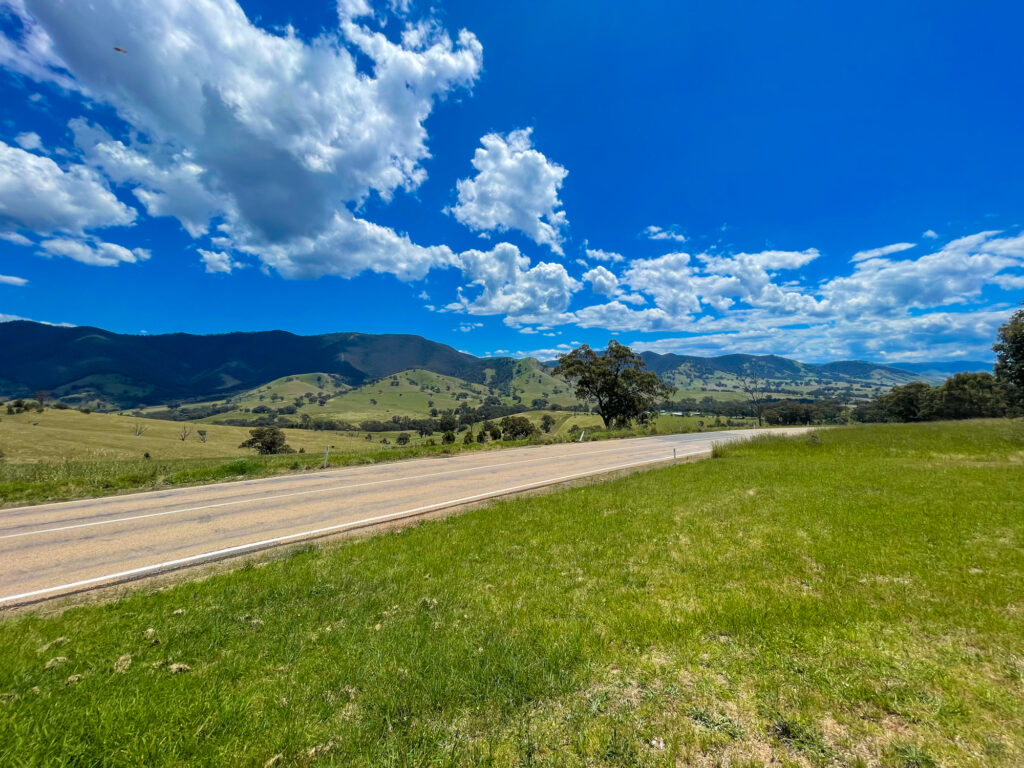
As you continue your journey, you’ll soon come across the charming town of Ensay. The town has a few local amenities, including a general store and a winery, the Ensay Winery, where you can sample some local wines and soak in the picturesque surroundings.
For those looking to explore the natural beauty of the area, there are a few bushwalking trails nearby, with opportunities to spot native wildlife and enjoy the tranquility of the Australian bush.

Situated at the junction of the Tambo and Nicholson Rivers, Bruthen is yet another gold rush-era town with heritage buildings and historical sites.
One of the town’s highlights, however, is the Bullant Brewery, a popular spot for sampling locally brewed craft beers and enjoying the laid-back atmosphere. The town also hosts the annual Bruthen Blues and Arts Festival, a lively event featuring live music, art exhibitions, and local food that attracts visitors from all over the region.
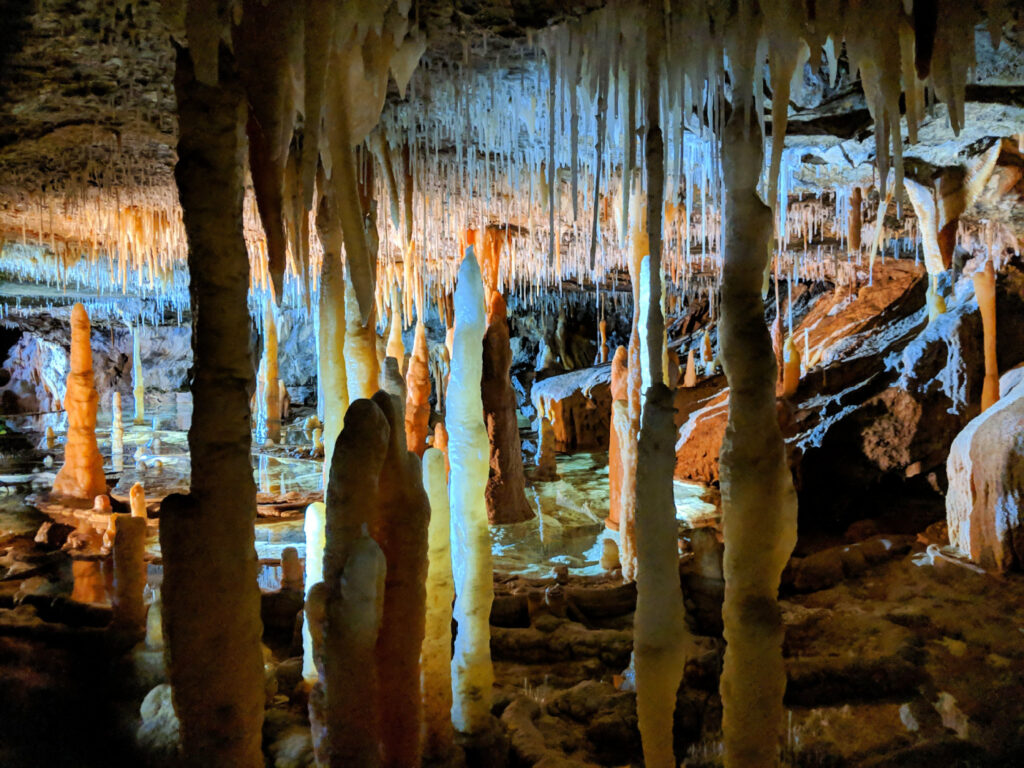
Once you’ve finished up in Bruthen, I’d recommend veering away from the Great Alpine Road and setting off another detour.
The Buchan Caves Reserve is world renowned for its spectacular limestone caves, which are among the most impressive in Australia. The reserve is roughly 80 km from Bruthen, but it’s well worth adding that additional time to your journey. These are some seriously incredible caves!
There are two main spots that are open to the public: the Royal Cave and the Fairy Cave, both of which are home to impressive stalactites, stalagmites, and even underground rivers.
You can jump on guided tours for each of these caves, and doing so offers up a safe and informative way to explore these subterranean marvels. The tours are suitable for most ages and fitness levels, with well-maintained paths and strategically placed lighting to help enhance your experience.
In addition to the caves, the reserve offers a variety of outdoor activities, such as bushwalking, birdwatching, and picnicking. There’s also a visitor center, a campground, and a playground for families with children.
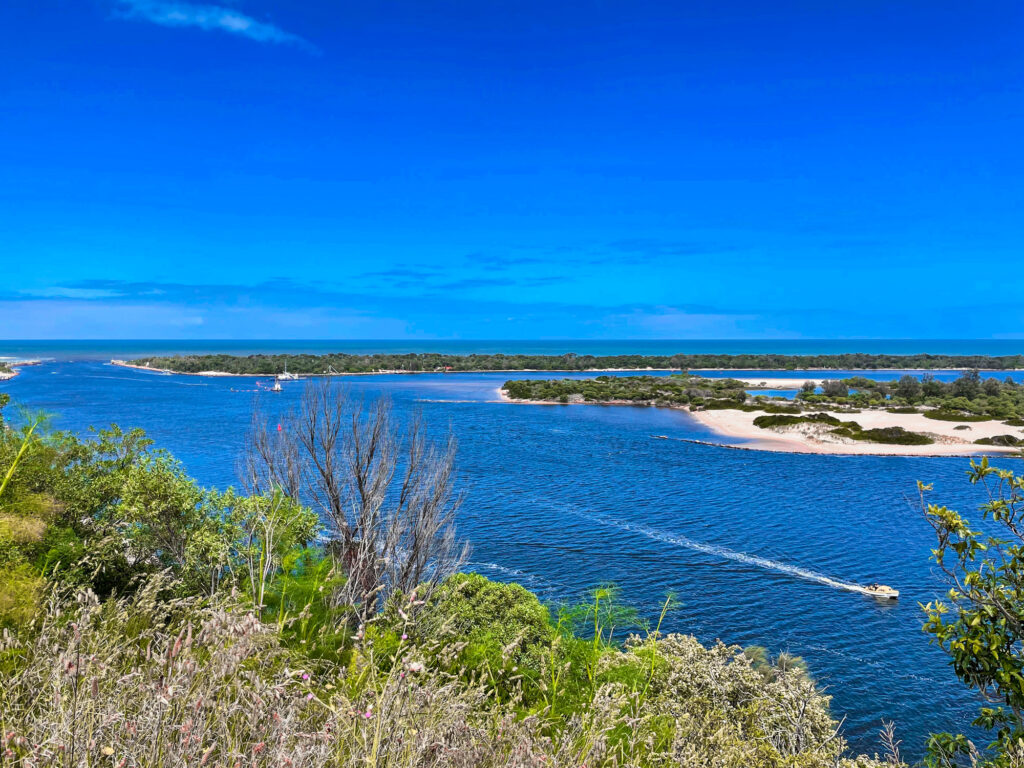
Yes, it’s true: we’re about to come to the end of the road. From the Buchan Caves, it’s time to jump in your car for one final drive, setting your GPS for Bairnsdale.
Bairnsdale is the official end point of the Great Alpine Road, and serves as a gateway to the Gippsland Lakes. If you do have additional time at the end of your road trip, we urge you to spend a couple of days in this beautiful part of Victoria.
The Gippsland Lakes is home to a large network of waterways, wetlands, and coastal lagoons, and it makes for a particularly picturesque setting. If you love your watersports, you’ll have dozens of options available to you, and if you’re not yet sick of winery-hopping, there’s plenty to sample around here.
Where to Stay in the Gippsland Lakes
When it comes to choosing where to stay, there’s several options.
Bairnsdale is one of them, but it’s our least favourite spot in the region. It’s the biggest town in East Gippsland, so it has the most accommodation options, but its inland location means it’s a bit lacking in tourist attractions and the restaurants aren’t amazing. We stayed at the Cottage on our most recent visit — an exceptional $200 a night holiday home that sleeps four.
Instead of Bairnsdale, though, we recommend opting to stay in either Lakes Entrance or Metung.
Lakes Entrance is best if you’re looking for lots of activities, watersports and hiking (take a look at Coastal Waters Motor Inn for accommodation) while Metung is great if you enjoy a peaceful environment without crowds of tourists (we’re big fans of the Moorings in Metung, which is within walking distance of the Metung Hotel: our favourite place to eat in the region!)
Our final recommendation for a place to base yourself is the wonderful Raymond Island. This tiny island is home to a whopping 250 koalas and they’re absolutely everywhere. Simply turn up on the island, look up at a gum tree, and there’ll most likely be a koala gazing back at you. Swan Cove Beachfront is a lovely holiday home on the island if you are keen to stay there. Even if you don’t spend the night in town, it’s still worth a quick stop on Raymond Island if you’ll be heading back to Melbourne.
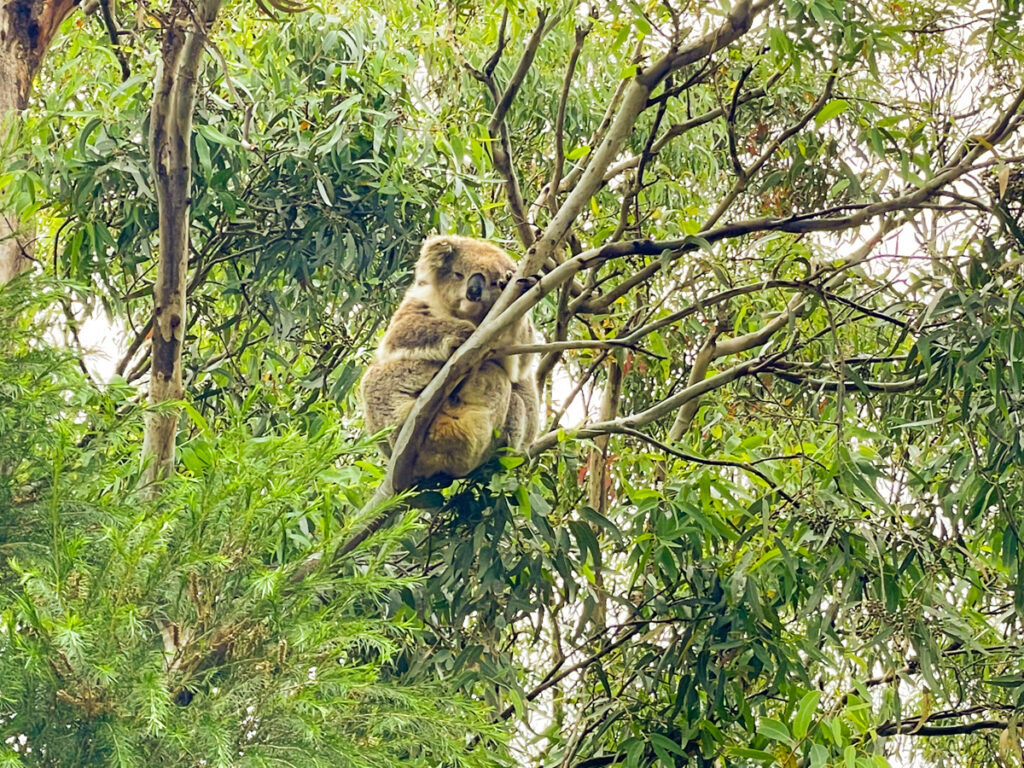
And That’s the Great Alpine Road!
Hopefully our love for the Great Alpine Road has shone through our words — we adore this part of Victoria and recommend it to everybody we meet.
With scenic mountain ranges, lush valleys, and picturesque vineyards, driving this route offers a wide range of experiences that we believe are suitable for everyone. Outdoor enthusiasts can find ample opportunities for hiking, cycling, and skiing, foodies can dive deep into the local produce, while those interested in history and culture can uncover the stories of historic towns and the local art scenes.
As you plan your journey along the Great Alpine Road, be sure to allocate enough time to explore its many side trips fully. Take advantage of the available lookout points and rest stops, and always ensure you have enough charge in your phone to take photos.
We hope you’ve found our guide to the Great Alpine Road useful. This truly is the resource we longed to have access to when we first decided to drive this route. If you have any questions, do drop us a comment below and we’ll get back to as soon as we can.
All images copyright Everything Victoria unless otherwise noted
